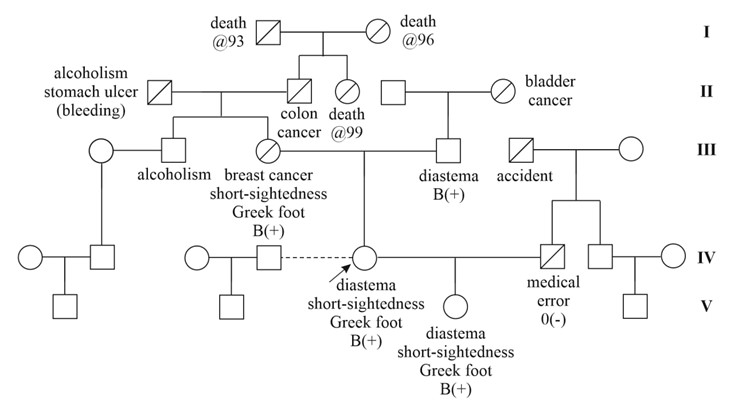Проблеми збору генетичного анамнезу, тлумачення родоводів з поширеними та рідкісними дерматологічними, скелетними, стоматологічними та іншими особливостями, які впливають на зовнішність та здоров’я людини
DOI:
https://doi.org/10.15587/2519-8025.2023.298576Ключові слова:
Родовід, аналіз родоводу, зовнішні ознаки людини, молекулярно-генетичний аналіз, ретроспективний генетичний аналізАнотація
Метою дослідження був аналіз проблеми побудови та тлумачення родоводів людини, які включають деякі ознаки, що легко виявляються при клінічному огляді та зборі первинного анамнезу.
Матеріали та методи. Представлені 2 родоводи з власних джерел та 2 родоводи відомих людей з літературних джерел, на прикладі яких продемонстровані можливості використання наданих даних для подальшого медико-генеалогічного аналізу.
Результати. Результати свідчать про те, що аналіз родоводу являє собою первинний та інформаційно важливий інструмент для подальшого алгоритму діагностики та лікування пацієнтів. Продемонстровано ефект кількості, якості та рівня тестування представленої генеалогічної інформації для повноцінного аналізу родоводів та використання їх можливостей. Аналіз родоводу показав, що кількість представлених абсолютних одиниць кількісної інформації (загальна кількість поколінь і членів родоводу) та абсолютних одиниць якісної інформації (перелічені ознаки/медичні стани та їх рівень деталізації) можуть не бути пов’язані із цінністю генетичних висновків. Таким чином, менші родоводи, де більше одиниць інформації представлено на члена, можуть мати більшу цінність для генетичних висновків. Продемонстровано, що найбільшу кількість членів у поколінні, як правило, представлено для покоління пробанда. Аналіз власних родоводів показав, що в середньому на одну людину в родоводі може бути представлено менше однієї ознаки. Крім того, невеликі родоводи з доступними молекулярно-генетичними даними можуть мати найбільшу цінність, навіть ретроспективно.
Висновки. Показано, що родоводи можуть представляти цінну первинну інформацію для клініцистів щодо подальшого алгоритму роботи з пацієнтом та слугувати інструментом розвитку науково-дослідницького мислення в навчальному процесі
Посилання
- Scherbakova, I., Ragi, S. D. (2022). Pedigree Analysis of Families and Patients Affected by Retinitis Pigmentosa. Retinitis Pigmentosa, 67–71. doi: https://doi.org/10.1007/978-1-0716-2651-1_5
- Huang, X., Elston, R. C., Rosa, G. J., Mayer, J., Ye, Z., Kitchner, T., Brilliant, M. H. et al. (2017). Applying family analyses to electronic health records to facilitate genetic research. Bioinformatics, 34 (4), 635–642. doi: https://doi.org/10.1093/bioinformatics/btx569
- Pettey, C. M., McSweeney, J. C., Stewart, K. E., Price, E. T., Cleves, M. A., Heo, S., Souder, E. (2014). Perceptions of family history and genetic testing and feasibility of pedigree development among African Americans with hypertension. European Journal of Cardiovascular Nursing, 14 (1), 8–15. doi: https://doi.org/10.1177/1474515114556198
- Evans, D. G. R., Barwell, J., Eccles, D. M., Collins, A., Izatt, L., Jacobs, C. et al. (2014). The Angelina Jolie effect: how high celebrity profile can have a major impact on provision of cancer related services. Breast Cancer Research, 16 (5). doi: https://doi.org/10.1186/s13058-014-0442-6
- Hawass, Z., Gad, Y. Z., Ismail, S. et. al. (2010). Ancestry and Pathology in King Tutankhamun’s Family. JAMA, 303 (7), 638–647. doi: https://doi.org/10.1001/jama.2010.121
- Labaf, A., Shahvaraninasab, A., Baradaran, H., Seyedhosseini, J., Jahanshir, A. (2019). The Effect of Language Barrier and Non-professional Interpreters on the Accuracy of Patient-physician Communication in Emergency Department. Advanced Journal of Emergency Medicine, 3 (4), e38.
- Marçon, C. R., Maia, M. (2019). Albinism: epidemiology, genetics, cutaneous characterization, psychosocial factors. Anais Brasileiros de Dermatologia, 94 (5), 503–520. doi: https://doi.org/10.1016/j.abd.2019.09.023
- Nemeth, V., Evans, J. (2022). Eczema. StatPearls. Treasure Island (FL): StatPearls Publishing. Available at: https://www.ncbi.nlm.nih.gov/books/NBK538209/
- Conery, M., Grant, S. F. A. (2023). Human height: a model common complex trait. Annals of Human Biology, 50 (1), 258–266. doi: https://doi.org/10.1080/03014460.2023.2215546
- Gokce, N., Basgoz, N., Kenanoglu, S., Akalin, H., Ozkul, Y., Ergoren, M. C. et al. (2022). An overview of the genetic aspects of hair loss and its connection with nutrition. Journal of Preventive Medicine and Hygiene, 63, E228–E238. doi: https://doi.org/10.15167/2421-4248/jpmh2022.63.2S3.2765
- Gurvits, G. E. (2014). Black hairy tongue syndrome. World Journal of Gastroenterology, 20 (31), 10845. doi: https://doi.org/10.3748/wjg.v20.i31.10845
- Uğur, S., Kaçar, C. (2019). Prednisolone-Induced Hairy Tongue: A Case Report. Archives of Rheumatology, 34 (3), 348–351. doi: https://doi.org/10.5606/archrheumatol.2019.7239
- Rosebush, M. S., Briody, A. N., Cordell, K. G. (2019). Black and Brown: Non-neoplastic Pigmentation of the Oral Mucosa. Head and Neck Pathology, 13 (1), 47–55. doi: https://doi.org/10.1007/s12105-018-0980-9
- Jaija, A. M. Z., El-Beialy, A. R., Mostafa, Y. A. (2016). Revisiting the Factors Underlying Maxillary Midline Diastema. Scientifica, 2016, 1–5. doi: https://doi.org/10.1155/2016/5607594
- Al Shanbari, N., Alharthi, A., Bakry, S. M., Alzahrani, M., Alhijjy, M. M., Mirza, H. A. et al. (2023). Knowledge of Cancer Genetics and the Importance of Genetic Testing: A Public Health Study. Cureus, 15 (8), e43016. doi: https://doi.org/10.7759/cureus.43016
- Aigbogun, E., Alabi, A., Didia, B., Ordu, K. (2019). Morton’s toe: Prevalence and inheritance pattern among Nigerians. International Journal of Applied and Basic Medical Research, 9 (2), 89–94. doi: https://doi.org/10.4103/ijabmr.ijabmr_128_18
- Ruby, J. G., Wright, K. M., Rand, K. A., Kermany, A., Noto, K., Curtis, D. et al. (2018). Estimates of the Heritability of Human Longevity Are Substantially Inflated due to Assortative Mating. Genetics, 210 (3), 1109–1124. doi: https://doi.org/10.1534/genetics.118.301613
- Basu, N. N., Hodson, J., Chatterjee, S., Gandhi, A., Wisely, J., Harvey, J. et al. (2021). The Angelina Jolie effect: Contralateral risk-reducing mastectomy trends in patients at increased risk of breast cancer. Scientific Reports, 11 (1). doi: https://doi.org/10.1038/s41598-021-82654-x

##submission.downloads##
Опубліковано
Як цитувати
Номер
Розділ
Ліцензія
Авторське право (c) 2024 Olga Filiptsova, Olga Naboka, Oleg Kryskiv, Andriy Zakhariev, Tetiana Martyniuk, Natalia Khokhlenkova, Olha Kaliuzhnaia, Svitlana Bobro, Liudmyla Petrovska, Yuliia Osypenko

Ця робота ліцензується відповідно до Creative Commons Attribution 4.0 International License.
Наше видання використовує положення про авторські права Creative Commons CC BY для журналів відкритого доступу.
Автори, які публікуються у цьому журналі, погоджуються з наступними умовами:
1. Автори залишають за собою право на авторство своєї роботи та передають журналу право першої публікації цієї роботи на умовах ліцензії Creative Commons CC BY, котра дозволяє іншим особам вільно розповсюджувати опубліковану роботу з обов'язковим посиланням на авторів оригінальної роботи та першу публікацію роботи у цьому журналі.
2. Автори мають право укладати самостійні додаткові угоди щодо неексклюзивного розповсюдження роботи у тому вигляді, в якому вона була опублікована цим журналом (наприклад, розміщувати роботу в електронному сховищі установи або публікувати у складі монографії), за умови збереження посилання на першу публікацію роботи у цьому журналі.









